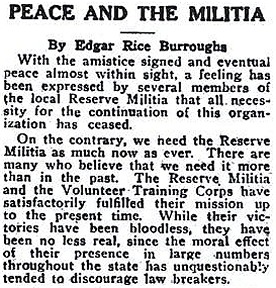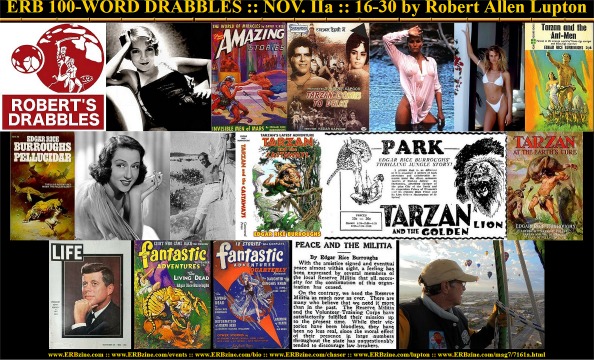
Official Edgar Rice Burroughs Tribute and Weekly Webzine Site Since 1996 ~ Over 15,000 Webpages in Archive Volume 7161a  |
ERB 100-Word Drabbles
NOVEMBER II Edition :: Days 16-30
See Days 1-15 at ERBzine 7161
by Robert Allen Lupton
With Collations, Web Page Layout and ERBzine Illustrations and References by Bill Hillman
STAY VIGILANT
November 16: On this day in 1918, “The Oak Parker” published an article by Edgar Rice Burroughs, “Peace and the Militia.” Oak Park, a town which grew rapidly in size after the great fire in Chicago in 1871, had two newspapers in the early days; “The Oak Park Times” and Oak Park Vindicator,” but they combined into one newspaper Oak Leaves” in 1902.
The magazine, “The Oak Parker” traces its origin to the “Weekly Alert”, in 1882. It survived until the 1960s, and a magazine using the same name has resumed publication. About the time that “The Oak Parker” vanished in the 1960s, the “Oak Park World” began publication.
In 1918, “The Oak Parker” absorbed a publication from a nearby city, the “River Forester” into the magazine.
Enough history, “Stay Vigilant,” is the drabble for today and is taken from Edgar Rice Burroughs’ article. Burroughs gave similar advice to the Hawaiian Islands during WW2.
The entire article is reproduced in this post, courtesy of ERBzine, may also be read at: https://www.erbzine.com/mag11/1169.html
STAY VIGILANT
![]()
On the contrary, we need the Reserve Militia as much now as ever. The past few days have clearly demonstrated that German propagandists are still among us. We have thrashed troublemakers of Europe, but we may have to deal with similar cattle here.
We cannot urge upon you too strongly the duty which confronts you as citizens, the appreciation of which may be best expressed by immediate enlistment in the Reserve Militia.”
JANE AT ANY AGE
November 17: On this day in 1967, the 41st episode of the Ron Ely Tarzan television series debuted. Titled “Pride of a Lioness,” the episode guest stared actor James MacArthur and his mother, Helen Hayes. MacArthur played Doctor Wilson and Helen Hayes, mimicking real life, played Mrs. Wilson, his mother. She and her son appeared together on “Hawaii Five-O” and “The Love Boat,” in addition to the Tarzan episode.
Tarzan intervenes on behalf of a very sick girl. He insists that rather than allow the girl to be treated by tribal medicine, she should be treated by real doctor. The tribe reacts poorly to his actions and other lives are put at risk.
Helen Hayes career began in 1910 and her last acting role was Miss Jane Marple in TV’s “Murder with Mirrors” in 1985. She didn’t appear on screen in the movie “Divine Mercy, No Escape” in 1987, but she was the narrator. She won one Academy Award and two Golden Globes for best actress. Quite a career. Oh, by the way, like Edgar Rice Burroughs, she received her own United States postage stamp.
“Jane at Any Age” is the drabble for today and it was inspired by Edgar Rice Burroughs and the ageless career of Helen Hayes.
JANE AT ANY AGE
![]()
Helen Hayes said, “I loved the books and movies. I always thought I’d be magnificent as Jane, but I never got the chance. I was busy when Elmo Lincoln made the first film. In the 1930s, the producers said I was too old and they hired Maureen O’Sullivan. They don’t know what they missed.”
“Mom, I’m sure that you’d have made a great Jane.”
“Of course I would have. Remember what I’ve always
said, “Age is not important unless you’re a cheese.”

IF A TREE FALLS
November 18: On this day in 1940, Edgar Rice Burroughs began writing “The Invisible Men of Mars,” the fourth and final installment of “Llana of Gathol.” The story was published in the October 1941 issue of “Amazing Stories” with a cover by J. Allen St. John, who also drew two interior illustrations.
Publishing details and book and magazine covers may be viewed at:
The Amazing Stories issue contains “Kidnaped in Mars” by Festus Pragnell (love the name), “Sergeant Shane of the Space Marines” by John York Cabot and two stories by the editor, Raymond Palmer, using his pseudonyms, “Mystery of the Martian Pendulum,” credited to Thorton Ayre and A. R. Steber and “A City on the Moon,” credited to Henry Gade. Life’s good when you get paid to edit and can buy your own stories.
“If a Tree Falls,” is the drabble for today and it was inspired by “The Invisible Men of Mars.”
IF A TREE FALLS
![]()
Carter obtained a supply of invisibility pills, rescued Llana, and the two escaped into the forest. The Invaks pursued them. One invisible warrior caught them. Carter took a pill, turned invisible, and the two warriors’ swords clashed and clanged through empty air.
Llana said, “Grandfather, I saw you kill that man.”
“No, you didn’t”
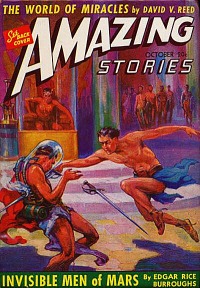
NEVER SAID I COULD SING
November 19: On this day in 1928, Indian professional wrestler, actor and politician, Dara Singh Randhawa, known professionally as Dara Singh, was born in Dharmuchak, a village that was then part of British Punjab. Singh played Tarzan in the 1965 Bollywood film, “Tarzan Comes to Delhi.” He also appeared in the film “Tarzan and King Kong,” but his younger brother played Tarzan in that film. Both films, like most Bollywood productions featured elaborate musical numbers.
Singh was a professional wrestler before he became an actor. At least three Bollywood Tarzans were professional wrestlers. Singh was elected to the WWE Hall of Fame in 2018. He appeared in hundreds of films and was elected to the Indian Upper House of Parliament in 2003. In a matter of speaking, that makes him the only Tarzan to be a Lord, except for the original, of course.
Singh's son Vindu Dara Singh, published a one shot comic book, “The Epic Journey of the Great Dara Singh” in conjunction with the Oxford Bookstore in New Delhi in February 2019.
More details about his life are available in my article at: https://www.erbzine.com/mag67/6736.html
Today’s drabble, “Never Said I Could Sing.”, is inspired by Edgar Rice Burroughs, Dara Singh, and the Bollywood Tarzan films. There were over 40 of them.
NEVER SAID I COULD SING
![]()
“Correct, the directors used a playback artist to dub my voice.”
“I don’t remember that.”
“No, they tried it my Tarzan film, but the entire sequence was canned. I couldn’t dance either. The director didn’t care. He hired me to swing, not sing, and I was famous, handsome and a great actor.
“But, you never sang in a film?”
“Isaac Singer made sewing machines. Hans Solo flew
space ships and Florence Nightingale was a nurse. My name doesn’t make
me a rock star.”
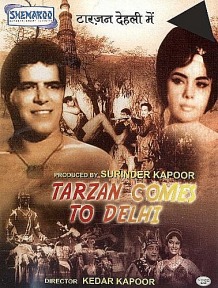
November 20: On this day in 1956, Actress Bo Derek (Mary Cathleen Collins) was born. She starred in “Bolero,” “10,” and “Tarzan, the Ape Man.”
Derek’s appearance in MGM’s R-rated “Tarzan, the Ape Man” in 1981 was her first leading role in a mainstream Hollywood film. Directed by her husband, John Derek, the film dealt little with Tarzan and instead focused on Derek's portrayal of Jane, and specifically on Derek's physical attributes. Several scenes of Derek wearing revealing outfits were featured, along with nude scenes of Derek being bathed and body-painted. Prior to the film's release MGM and the film's distributor, United Artists were sued by the ERB estate over the name of the film, as Derek's role and body overshadowed the story of Tarzan. Although the film received negative reviews from many critics, Tarzan, the Ape Man became a box-office success, making over $35 million in ticket sales and was the 15th highest grossing film of the year.
The actor and boxer, Lee Canalito, originally cast to play Tarzan, was fired early during the production. Rumors abound concerning why he was terminated, or quit, as the case may be.
Derek shared the Golden Raspberry Award for Worst Actress with Faye Dunaway, the latter for her starring role as Joan Crawford in “Mommie Dearest.”
Derek is mostly retired and lives in California. Her last two films were “Sharknado 3: Oh! Hell! No!” and “The Last Sharknado: It’s About Time.” She played Mae Wexler in both films.
Today’s drabble, “Box Office, Baby,” was inspired by Edgar Rice Burroughs and the 1981 film. “Tarzan, the Ape Man.”
BOX OFFICE, BABY
![]()
“We came to an understanding that he wouldn’t continue in the role. Miles O’Keefe is our new Tarzan. He’ll be great.”
“Why did the other guy quit?”
“Artistic differences. He wanted Tarzan to have as more lines in the film as Jane does. I disagreed. I told him that this isn’t the 1930s. Nobody knows who he is and everyone knows who you are. People will line up to see you. In today’s world “B-O” stands for Box Office.”

LOLLYPOP
November 21: This is the 900th consecutive daily drabble in this series and on this day in 1953, actress Nicolette Sheridan was born in Worthing, England. Nicolette voiced Eleanor, Jane Porter’s friend in several episodes of the television series, “The Legend of Tarzan” and the “Tarzan and Jane” Disney DVD.
Nicolette is the daughter of actress, Sally Adams, who gave birth to her at age 16. Sally, billed as Dani Sheridan, was one of Blofeld’s “Angels of Death” in the Bond film “On Her Majesty’s Secret Service.” Sally became involved on set with actor, Telly Savalas, and the two lived together thereafter. Sally and Nicolette moved to California with Savalas, where Telly functioned as Nicolette’s stepfather.
Nicolette is best known for her role on “Desperate Housewives” and the reboot of “Dynasty.”
She has worked consistently in television and film, appearing on such diverse shows as “Will and Grace.” “Becker,” and ‘Paradise,” She played Paige Matheson on the soap opera, “Knots Landing,” for seven years, winning Soap Opera Digest’s awards for Outstanding Lead Actress and Outstanding Heroine for her work on that prime time soap opera. She has had roles in over 20 made for TV films.
The drabble for today, “Lollypop,” is inspired by her story and of course, always honors the works of Edgar Rice Burroughs, with a tip of the hat to good stepfathers and stepmothers everywhere.
LOLLYPOP
![]()
“Talk to your daddy. Telly will help. He knows everyone in Hollywood.”
“He’s not my father.”
He pays the bills, loves us both, and takes care of everything. He went to your dance recitals and your school plays. That makes him your father.”
Nicolette told Telly Savalas she wanted to be an actress.
He said, ‘That’s great. I’ll enroll you in Lee Strasberg’s
classes next week. He’s the best. He teaches method acting.”
“You’ll do that for me? The best dad, ever.”
“Of course. Who loves ya, baby. Have a lollypop.”

ELUSIVE EDITION
November 22: On this day in 1923, Edgar Rice Burroughs finished writing “Tarzan and the Ant Men.” The novel, 86,000 words in length, was serialized in seven installments in “Argosy All Story Weekly” from February 2 through March 15, 1924. A. C. McClurg published the first edition on September 30, 1924. Robert B. Zeuschner lists a mixed edition (McClurg and G & D) wherein it says A. C. McClurg on the title page, but Grosset and Dunlap on the spine. Robert B. Zeuschner goes on to identify 7 printings by Grosset & Dunlap, the last one in 1967.
A Whitman Better Little Book, with a cover by John Coleman Burroughs, was published in 1945. The BLB reprinted the illustrations from the 1932 Tarzan daily comic strip drawn by Rex Maxon.
Ballantine/ Del Rey printed editions from 1963 through a 1989 Canadian edition, for a total of thirteen known printings. (The Canadian edition appears to be identified as #14, but no evidence of a 13th printing is known to exist.) Jim Goodwin’s “Edgar Rice Burroughs The Descriptive Bibliography of the Ace and Ballantine/Del Rey Paperback Books” verifies the absence of a 13thpaperback edition.
The illustration is from a Four Square British edition of the book. For several covers and more details about the novel, visit https://www.erbzine.com/mag4/0497.html
The drabble for today features my old friends and Burroughs fanatics from New Orleans, Pat and John, and is entitled, “Elusive Edition.” As always, it’s based on the works of Edgar Rice Burroughs.
ELUSIVE EDITION
![]()
“Pat, there isn’t a number thirteen. Maybe the Canadians skipped from twelve to fourteen. Thirteen is unlucky.”
“You don’t want to admit that you missed one.”
“No, lots of hotels never have a room thirteen.”
“Weak excuse.”
“Not true. It’s a Burroughs tradition. He changed
the name of his novel “Number Thirteen” to “The Monster Men” before publication.”
“Got me there.”
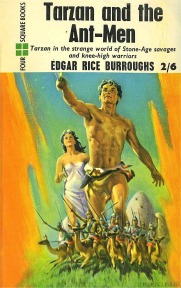
ON A CLEAR DAY YOU CAN SEE FOREVER
November 23: On this day in 1914, Edgar Rice Burroughs began writing, “Pellucidar,” the sequel to “At the Earth’s Core.” The 61,000 word novel was originally serialized in four parts beginning on May 8, 1915 in “All-Story Cavalier Weekly.” The magazine changed its name to “All-Story Weekly” before part two was published on May 15, 1915.
Modest Stein drew the cover for the first issue. The first edition was published by A. C. McClurg on September 5, 1923, with a cover by J. Allen St. John with a print run of 10,000.
The book has been consistently reprinted, including editions by Grosset & Dunlap, Canaveral Press, Ace Books (With covers by Frazetta and Krenkel), Dover, Castle, Ballantine, Quiet Vision, Wildside, ERBville, and Bison Frontiers, an imprint by the University of Nebraska. Foreign editions include Japanese, Dutch, and British. Bob Zeuschner lists 29 separate US editions in his book, "Edgar Rice Burroughs The Bibliography" (2016).
The Ace Book cover included herewith is by the remarkable Frank Frazetta. For more work by Mr. Frazetta, go to
The drabble for today, “On A Clear Day You Can See Forever,” was inspired by the Pellucidar series by Edgar Rice Burroughs.
ON A CLEAR DAY YOU CAN SEE FOREVER
![]()
“Not at all, Bob. There’s a central sun, no industrial smoke, clear skies, clean water, and there is no nightime. Pellucidar was a perfect choice.”
“And the people?”
“The residents have pellucid motives, eat, sleep,
survive, and mate. The noble savages aren’t distracted by civilized nonsense
- Pellucid!
“If you say so.”
“I do and my motives are perfectly pellucid as well.
When may I expect my check?”
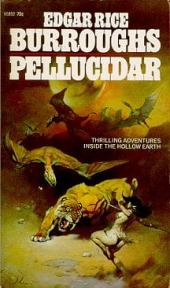
LEAD ON McDUFF
November 24: On this day in 1967, the season two episode of the Ron Ely Tarzan television show titled “Mountains of the Moon Part One” was broadcast. Part Two followed a week later. The episode featured veteran actress, Ethyl Merman, Strother Martin, and Sabrina.
Tarzan came across a party of religious pilgrims who were being lead by Rosanna McCloud, played by Ethel Merman, to their "Promised Land". To not shatter their dreams, Mrs. McCloud didn’t inform her followers that her husband, whom they regarded as their Prophet, had been killed. She didn’t know that trader who sold the group the land from a reclusive tribe had his own motives for doing so and never intended for the group to reach it. Indeed, he intended for them to die in route.
After Tarzan’s arrival, Rosanna finally tells her group about the death of their leader. She and Tarzan also find that their money has been stolen.
Can Tarzan save the pilgrims, recover their money, and lead them to their new home? Since the prophet is dead, you’ll have to watch the episodes to find out.
Ethel Merman was born in Astoria, New York as Ethel Agnes Zimmerman. She was a star of stage and screen, known for her phenomenal vocal skills. She won one Tony award. Her recordings of ‘Everything’s Coming up Roses,” “You’re the Top,”, “Anything Goes,” “ Who Could Ask for Anything More,” and “There’s No Business Like Show Business” are American classics. It was said that she could teach a sailor to swear. More about her on her birthday.
On a personal note, she was hilarious in “It’s A Mad, Mad, Mad, Mad World."
Today’s drabble, “Lead on McDuff” is inspired by the works of Edgar Rice Burroughs and contains a real quote (about the piano) from Ethel Merman.
LEAD ON McDUFF
![]()
“My husband, God rest his soul, said God would lead us to the Promised Land. I have a map. Here it is.”
“This land belongs to a jungle tribe.”
“I got a bill of sale. Can you take us there?”
“Yes, but are you sure you want to follow me?”
“Why not, I always said that I wouldn't trust any
man as far as you can throw a piano, but it looks like you could throw
a piano pretty damn far. Lead on, McDuff.”

SWINGING IN THE RAIN
November 25: On this day in 1959, Stellan Sven Windrow died in New York City.
Windrow stood 6 feet four inches tall and was an all-around athlete at the University of Chicago (Swimming, Track, Shotput, and Discus). He was a member of the Alpha Tau Omega fraternity and the Blackfriars Drama Society.
Stellan was originally cast in the role of Tarzan for the 1918, “Tarzan of the Apes,” silent film and all of the tree work was his. Stellan used a ground level trampoline to make fourteen foot leaps into the trees, where he performed death-defying swings in the tree tops over sharp boulders on slippery hemp ropes constructed to resemble natural vines.
After five weeks of shooting, and with the treetop work nearly completed, Stellan Windrow was drafted into World War I, where which he served as an ensign in the Navy. He received $1000 for his film rights, and wasn’t credited in the film. A frantic search began for his replacement, ending a when D.W. Griffith selected Elmo Lincoln. Lincoln was stocky, afraid of heights, and didn’t do any tree-work. The movie features two Tarzans — the limber, athletic Stellan -- Tarzan flying through the jungle canopy, and barrel-chested Elmo -- the Tarzan on the ground.
After Tarzan and World War One, Stellan moved to London and married Marjorie Desborough and had two daughters, Marjorie and Patricia, The Windrows moved to a suburb of Paris, where he worked for Paramount Pictures. Near the end of the 1930s they returned to New York where he worked as a free-lance newspaper/magazine photographer. He served in the American Red Cross during World War II, in North Africa.
Some authors have referred to him as “Windrow Wilson,” in their books, but there is no evidence that he ever used this name at any point. The cast members of “Tarzan of the Apes” nicknamed him, “Steamboat,” because S. S. Windrow sounded like the name of a ship.
The photograph is of Stellan hanging outside the boat used to haul the cast, crew, and equipment around Bayou Teche during the filming.
Extensive information about Stellan Windlow is available at: https://www.erbzine.com/mag28/2876.html
“Swinging in the Rain,” the drabble for today was inspired by Sellan Windlow and the works of Edgar Rice Burroughs.
SWINGING IN THE RAIN
![]()
“I’ll try. Thank you.”
“Will you miss Hollywood?”
“Bayou Teche, Louisiana is a long way from Hollywood,
but I’ll tell you what I will miss.”
“What’s that?”
“I won’t miss the bugs, heat, or the rain. My hands
are raw from the rough ropes. I can’t speak for the real Tarzan, but grabbing
the vines and launching myself from tree to tree – Wow! I really love to
swing.”
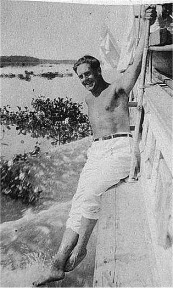
TARZAN OF THE ISLANDS
November 26: On this day in 1940, Edgar Rice Burroughs began writing “Tarzan and the Castaways.” The story was originally written using the title, “The Quest of Tarzan,” and published under that title by Argosy Weekly in three parts (August 23, August 30,, and September 6, 1941. The first installment had Tarzan on the cover, a shadow illustration by Virgil Finley.
“The Quest of Tarzan” was retitled “Tarzan and the Castaways” in 1964 to avoid confusion with the novel, “Tarzan’s Quest,” and combined with “Tarzan and the Jungle Murders” and “Tarzan and the Champion,” to make up the hardcover book, “Tarzan and the Castaways,” published by Canaveral Press with a cover by Frank Frazetta. In the hardcover edition of “Tarzan and the Castaways,” the date "1965" appears on the title page, and "Copyright 1965" on the copyright page, of about 400 copies distributed in December 1964. Further distribution was halted until January 2, 1965, for the printing of a sticker to be affixed to the copyright page of the remainder of the edition, correcting two other errors and giving the copyright date of this book as "Copyright 1964". The ironic thing about all this is that the copies distributed in 1965 bear a 1964 date, while those distributed in 1965 are labelled 1964 on the copyright page.
Extensive details about the story and the book are available at:
Ballantine released a paperback edition in July 1965. Jim Goodwin identifies 13 Ballantine / Del Rey editions of the book in his “EDGAR RICE BURROUGHS THE DESCRIPTIVE BIBLIOGRAPHY OF THE ACE AND BALLANTINE/DEL REY PAPERBACK BOOKS.
The drabble for today is “Tarzan of the Islands,” written by some unknown editor or publicist, and taken from the blurb on the Ballantine edition of the book.
TARZAN OF THE ISLANDS
![]()
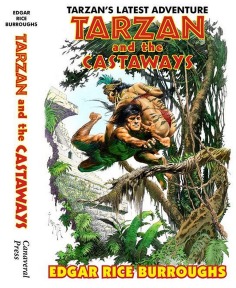
ALL THAT GLITTERS
November 27: On this day in 1927, “The Mansfield News” in Mansfield, Ohio published a review of the film, “Tarzan and the Golden Lion,” a film whose script didn’t even pretend to follow the book. Here’s the review in its entirety.
“So many have read the "Tarzan" stories by Edgar Rice Burroughs that FBO company have filmed one of his novels. That novel, "Tarzan and the Golden Lion.", in its film adaptation will be seen today and through Wednesday at the Park.
The theme deals with Tarzan's life on his plantation in central Africa, with his wife, Lady Greystoke and their niece, Ruth Porter, who is in love with Burton Bradney, the overseer of Tarzan's domain. One of the first exciting moments in the picture is the arrival of an escaped slave from the Palace of Diamonds in a hidden city. To fortify his tale of the unbelievable treasures stored in the Palace, the slave has brought a bag of diamonds with him. However, as the plans for an expedition to the city are being made, an unseen figure is listening at the window, and Tarzan's difficulties in reaching the Palace are made almost insurmountable through his efforts. Thrills and romance are woven in the adventurous quest which ends in happiness in spite of all obstacles. J. P. McGowan is responsible for the masterful direction while credit for the adaptation and continuity go to William R. Wing.”
Burroughs’ son in law, James Pierce, who appeared as Tarzan in the film, might have taken issue with the review. "Because of poor direction, terrible story treatment and putrid acting, the opus was a stinkeroo. I emerged with nothing to show for my strenuous effort except being typecast as Tarzan. I was out of a job."
The film was considered a lost film for years, but Pierce never gave up looking for a copy until he died. After his death, a complete print was located in the 1990s.
The drabble for today, “All That Glitters,” is based on the film and the works of Edgar Rice Burroughs.
ALL THAT GLITTERS
![]()
“No, as time has passed, I’ve come to appreciate the
film. It’s a rare treasure.”
“Hurry back, we record a radio episode this afternoon.
I can’t believe you really want to find a print.”
James said, “It may have been brass at the box office,
but it’s gold to me.”
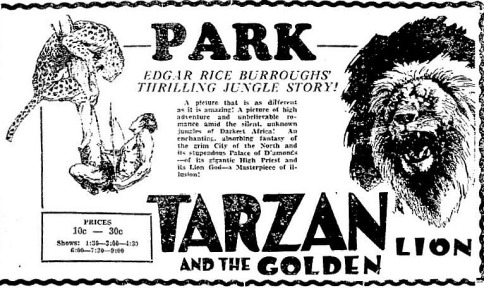
DOES ANYBODY REALLY KNOW WHAT TIME IT IS?
November 28: On this day in 1930, Metropolitan Books published the first edition of “Tarzan at the Earth’s Core,’ and on this day in 1962, Canaveral Press re-published the book. The price increased by 95 cents from $2.00 to $2.95 over those 34 years. Hardback books generally sell for more than $25.00 a copy these days. The Metropolitan first edition had a dust jacket and frontispiece by J. Allen St. John. The Canaveral Press edition had a dust jacket and eight interior illustrations by Frank Frazetta.
While this is not intended to be a complete bibliography, here’s a bit more information about US published editions. Edgar Rice Burroughs The Bibliography by Bob Zeuschner identifies three Grosset & Dunlap editions, One Burroughs Inc. edition (there’ll soon be another), two Canaveral editions, and 24 paperback editions by Ace or Ballantine / Del Rey. Other editions have been published by Avenal, Gramercy, Amereon House, Bison Frontiers of the Imagination, and three editions by Erbville Press. Jim Goodwin lists 25 paperback edition by either Ace or Ballantine / Del Rey in his “Edgar Rice Burroughs The Descriptive Bibliography of the Ace and Ballantine /Del Rey Paperback Books. Joe Lukes may list more Grosset & Dunlap editions in his Burroughs Bibliography by that publisher, but I confess that I haven’t located my copy.
Details about the publishing history of the book and several illustrations are available at:
DOES ANYBODY REALLY KNOW WHAT TIME IT IS?
![]()
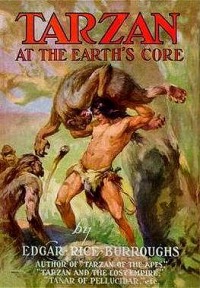
I LIKED THE BOOK BETTER
November 29: On this day in 1963, Life Magazine published the article “Tarzan of the Paperbacks,” written by Paul Mandel, a staff writer for Life Magazine for several years.
The opening paragraph of the article is:
“Two years ago, a lady librarian in California took a Tarzan book off the shelf on the spoilsport grounds that Tarzan and Jane were living together out of wedlock. She could have had no inkling of the consequences of her misguided act. The furor it aroused in newspapers has brought the Ape Man roaring back out of literary limbo to delight millions of nostalgic Americans and thrown a bomb into the paperback book business.”
The cover of the issue is a photograph of John Fitzgerald Kennedy and the primary focus of the issue is the death and a memorial to President Kennedy. Several copies of the issue are listed on EBay with prices ranging from $4.99 to $38.00. The entire article may be read at:
I LIKED THE BOOK BETTER
![]()
Until the most recent movies the film Tarzan tended to be a treebody keeping pretty close to home with Jane, while the book Tarzan is a veritable boulevardier.
Lest any heretic dispute the superiority of the book Tarzan over the Hollywood Tarzan, he should read one of the newly reprinted paperbacks “Tarzan and the Lion Man.” In its last chapter Tarzan visits Hollywood incognito. He is offered a chance to play the lead in a Tarzan movie but flunks the screen test and loses out to an adagio dancer.”
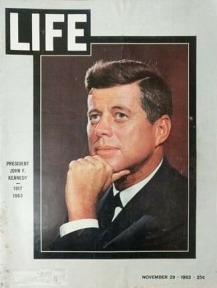
YOU'RE NOT THE BOSS OF ME
November 30: On this day in 1941, Fantastic Adventures published, “The Living Dead,” which became part three of the four parts of the novel. “Escape on Venus. The magazine cover was by J. Allen St. John – as were two interior illustrations.
“The Living Dead” was reprinted in Fantastic Adventures Quarterly in the summer of 1942 with a magazine cover by Frank Durban. The quarterly reprinted the J. Allen St. John interiors from the earlier publication of the story. Burroughs was paid $400.60 for the story. The issue contained five other stories: “Eight Who Came Back” by Nat Schachner, “Al Addin and the Infra-Red Lamp” by William P. McGivern, ”The Man from the Future” by Don Wilcox, “The Genius of Mr. Pry” by Duncan Farnsworth, and “Henry Horn’s Super-Solvent” by Dwight V. Swain
More details about “Escape on Venus” and several illustrations are available at:
The drabble for today is “You’re Not The Boss of Me,” and it’s based on the citizens of Voo-Ad, created by Edgar Rice Burroughs.
YOU'RE NOT THE BOSS OF ME
![]()
Their ruler, Vik-vik-vik, explained that the strange reddish dividing line running from top to bottom was the Vooyorgan’s method of reproduction. They split and each half becomes another complete creature.
Duare said, “These people are talking amoebas.”
“On my world, we have a name for people with split
personalities. It’s called dissociative identify disorder and the identities
fight over who’s in charge.”
“Here,” said Vik-vik-vik. “The halves fight about who
keeps their old name. They never quit or shut up.”
“Sounds like home.”
A right half from Voo-Ad threw a fit
He fought his left side once they’d split
Each demanded their old name
And the other the same
Saying, you pick a new name, hypocrite.
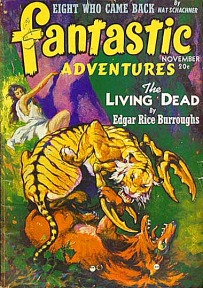
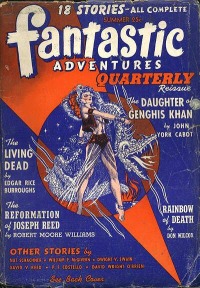
![]()
![]()
See
Days 1-15 at ERBzine 7161
![]()
NOVEMBER IIa ILLUSTRATIONS COLLAGE
![]()
